#dominique saint pierre
Explore tagged Tumblr posts
Text

[request box] dominique, singing on stage
31 notes
·
View notes
Text

vampire girl
#legend of the galactic heroes#logh#lotgh#elfriede von kohlrausch#dominique saint pierre#lesbian art#my art
25 notes
·
View notes
Text

#legend of the galactic heroes#ginga eiyuu densetsu#logh#dominique saint pierre#elfriede von kohlrausch#domifriede
37 notes
·
View notes
Text


giving dom + el the furry treatment too. thumbnails of a WIAW scene and workshopping their designs
#logh#elfriede von kohlrausch#Dominique Saint Pierre#legend of the galactic heroes#fanart#furry#I don’t know how to draw figures anymore lol#procreate#wip
28 notes
·
View notes
Text

This ship always gives me Roman Holiday (a Halsey song) vibe.
7 notes
·
View notes
Text
A gift for myself as I've gotten to napoleonic fandom for 1000(+3) days🥰!
#napoleonic wars#napoleon bonaparte#louis alexandre berthier#geraud duroc#jean lannes#joachim murat#jean baptiste bessières#pierre augereau#andre massena#michel ney#laurent de gouvion saint cyr#auguste de marmont#edouard mortier#jean de dieu soult#jean andoche junot#jean baptiste bernadotte#dominique jean larrey#nicolas charles oudinot#louis nicolas davout#barclay de tolly#pyotr bagration#mikhail miloradovich#alexey arakcheev#alexander i of russia#mikhail speransky#sir sidney smith#talleyrand#joseph fouché#horatio nelson#arthur wellesley
220 notes
·
View notes
Text
The ends of the Marshals
We know a lot about our marshals of empires, but for some their existence ends in 1814, I did some research and I did all the dates of death of the 26 marshals of the empire with their age of death and some information that I had, do not hesitate to say other information if you have any, when we look closely Lannes was the first to die and at a young age while the one who spent the most time on earth is Moncey who lived until 87 years old, yet it is Marmont who will be the last to die in 1852, I hope that this will be useful for some.
Shot:
-Murat, October 13, 1815 (trying to recover his former kingdom of Naples …) at 48 years old
-Ney, December 7, 1815 (judged as a traitor for having joined Napoleon in 1815) at 46 years old
Defenestrate: (throw at a window)
-Berthier, June 1, 1815 (suicide or murder?) at age 61
Killed in combat:
-Lannes, May 31, 1809, wounded in the leg, dies of his wounds, at age 40
-Bessières, May 1, 1813, wounded by a cannon (no chance of survival) at age 44
-Poniatowski, October 19, 1813, drowned during the battle of Liepzig, at age 50
assassinated:
-Brune, August 2, 1815 (victim of the white terror of 1815) at age 52
-Mortier, July 28, 1835 (killed in an attack) at age 67
illness:
-Davout, June 1, 1823 (probably of tuberculosis) at age 53
-Augereau, June 12, 1816, at age 58
-Masséna, April 4, 1817 (long-term ill) at age 58
-Gouvion Saint-Cyr, March 17, 1830 (stroke) at age 65
natural causes, old age: (Here it is mainly deaths from natural causes)
-Perignon, December 25, 1818, at age 64
-Serurier, December 21, 1819, at age 77
-Lefebvre, September 4, 1820, at age 64
-Kellermann, September 14, 1820, at age 85
-Suchet, January 3, 1826, at age 55
-Jourdan, November 23, 1833, at age 71
-MacDonald, September 25, 1840, at age 74
-Victor, March 1, 1841, at age 76
-Moncey, April 20 1842, at age 87
-Bernadotte, March 8, 1844 (died of a paralytic attack at age 81)
-Grouchy, May 29, 1847, at age 80
-Oudinot, September 13, 1847, at age 80
-Soult, November 26, 1851, at age 82
-Marmont, March 2, 1852, at age 77
#history#napoleonic era#napoleon's marshals#michel ney#joachim murat#louis nicolas davout#louis alexandre berthier#jean mathieu philibert sérurier#jean lannes#jean baptiste bessières#jean baptiste jourdan#jean baptiste bernadotte#joseph antoine poniatowski#pierre augereau#claude victor perrin#jean de dieu soult#edouard mortier#nicolas charles oudinot#emmanuel grouchy#auguste de marmont#louis gabriel suchet#etienne macdonald#catherine dominique perignon#françois joseph lefebvre#françois christophe kellermann#jean mathieu philibert serurier#adrien moncey#andré masséna#laurent gouvion saint-cyr
102 notes
·
View notes
Text
I drew all 26 of Napoleon's marshals



#napoleonic wars#napoleon’s marshals#do i just tag all of them#Louis-Alexandre Berthier#Joachim Murat#Bon-Adrien Jeannot de Moncey#Jean-Baptiste Jourdan#André Masséna#Pierre Augereau#Jean-Baptiste Bernadotte#Guillaume Brune#Jean-de-Dieu Soult#Jean Lannes#Édouard Mortier#Michel Ney#Louis-Nicolas Davout#Jean-Baptiste Bessières#Claude Victor-Perrin#Jacques MacDonald#Nicolas Charles Oudinot#Auguste de Marmont#Louis-Gabriel Suchet#Laurent de Gouvion Saint-Cyr#Józef Antoni Poniatowski#Emmanuel de Grouchy#François Christophe de Kellermann#François Joseph Lefebvre#Catherine-Dominique de Pérignon#Jean-Mathieu-Philibert Sérurier
60 notes
·
View notes
Text
Downgrade of the fucking century


4 notes
·
View notes
Text
Unwavering Faith: Aveline and the Colonial Assassins (Analysis)

Over the years, I've come to notice a dual parallel and theme between the premise of AC Rogue and the side title, Liberation:
The loss of faith. Despite its intentionally ambiguous portrayal of the Assassins, Liberation compellingly explores their flaws, contradictions, and hidden layers through characters like Agate and François Mackandal respectively. This, in turn, profoundly impacts Aveline's mental state and her faith in her sect of the Colonial Assassins and their Creed.

Mackendal, in particular, was a very fascinating character not just in the historical context, but in what he encompassed for the ideals and values of the Assassins when pressed to their logical extreme in using their Creed as a policy for aggression, violence, and unrestrained use of power. An example of this is how he aimed to poison the colonists in Saint-Dominique.
The Mackandal Rebellion (1750-1758) | Haitian Revolution (1791-1804)
What's interesting is that despite his atrocities, Mackandal didn't think he was a traitor of any kind to the Brotherhood or what it preached. Much Like Altair who didn't believe so when he killed his Mentor. Neither did Pierre Bellec when he killed Mirabeau in Unity. Mackandal, in fact, firmly believed he was an Assassin, even truer than the Colonials themselves. From his perspective, he didn't kill "innocents." He just didn't see any of the "white masters" at the time as remotely innocent. Clearly, he was wrong from any other point of view, but it doesn't make him less of an Assassin. After all, the Creed does allow it if you want it to.

In some regards, he shares a sharp contrast with Adewale himself. Both men are shaped by their brutal experiences as slaves, embodying contrasting conclusions with the Assassin's Creed. Mackandal, corrupted by deep-seated anger, employs ruthless and indiscriminate methods such as poisonings, reflecting a radical approach that often causes collateral damage that ultimately catches up to him destroying himself and his Brotherhood. In contrast, Adewale, motivated by a strong sense of justice and compassion, remains steadfast in his convictions and humanity for himself and others. As a result, Mackandal's legacy is often treated as a cautionary tale, while Adewale retaining his morals and principles through the Creed is still remembered and admired by even individuals like Evie Frye an entire century later. This duality between them underscores the larger internal struggle that individuals within the Brotherhood face in response to both oppression and their endless fight for and to preserve freedom. This era of the Assassins, especially, is faced with this dilemma where the very freedom that they fight for is often short-lived, imperfect, nuanced, and bittersweet. 'Laid to Rest' Transcript

Connor: "My father is dead. Charles Lee now leads the Templar Order in his place. I see now why ours is an eternal war. For each piece taken from the board, another is placed upon it. Back and forth we go. Across the world. Across the ages. Some days, mine feels an impossible task, but I cannot afford to be consumed with doubt. The people need me. Now, more than ever. I must stop the Templars. I will kill Charles Lee." Connor's Forsaken Epilogue Soliloquy Connor: "So many voices, each demanding something else… It has been hard at times, but never harder than today to see all I worked for; perverted, discarded, forgotten!"

This brings us to the inner turmoil and duality that Aveline struggles with over the course of her story. Who is she really? Why does she fight? Is it even worth the effort to fight at all in such an unjust world?
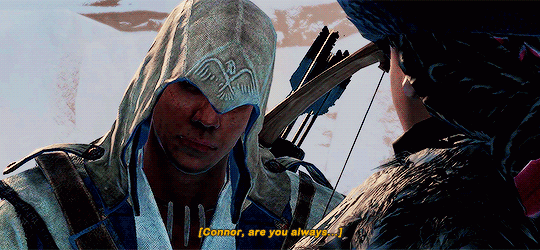

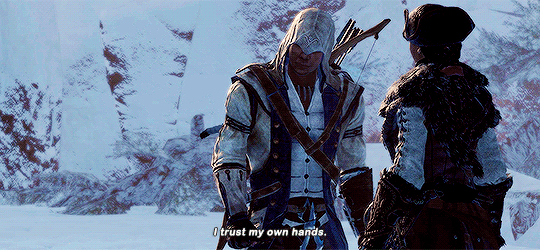
"I trust my own hands," I believe, is Connor expressing his adherence to individualism above all else. For him, it signifies the realization that even the people and institutions you serve can be flawed or have misguided intentions, and you must trust your own judgment. This mindset makes Connor an embodiment of the Creed and its ideals—an approach that Aveline also adopts. Her persistent fight for choice and freedom, despite the hypocrisy, corruption, and fallibility within her own order, makes her dedication as an Assassin truly compelling. Because Aveline is more than just an Assassin. She is a liberator.
#assassin's creed#connor kenway#ratonhnhaké:ton#adewale#assassin's creed 4#ac liberation#aveline de grandpre#francois mackendal#achilles davenport#assassin's creed rogue#shay patrick cormac#seriously the colonial era was super interesting for both groups#Aveline deserves some appreciation too y'all#Her arc is seriously underrated
43 notes
·
View notes
Text
Friends, enemies, comrades, Jacobins, Monarchist, Bonapartists, gather round. We have an important announcement:
The continent is beset with war. A tenacious general from Corsica has ignited conflict from Madrid to Moscow and made ancient dynasties tremble. Depending on your particular political leanings, this is either the triumph of a great man out of the chaos of The Terror, a betrayal of the values of the French Revolution, or the rule of the greatest upstart tyrant since Caesar.
But, our grand tournament is here to ask the most important question: Now that the flower of European nobility is arrayed on the battlefield in the sexiest uniforms that European history has yet produced (or indeed, may ever produce), who is the most fuckable?
The bracket is here: full bracket and just quadrant I
Want to nominate someone from the Western Hemisphere who was involved in the ever so sexy dismantling of the Spanish empire? (or the Portuguese or French American colonies as well) You can do it here
The People have created this list of nominees:
France:
Jean Lannes
Josephine de Beauharnais
Thérésa Tallien
Jean-Andoche Junot
Joseph Fouché
Charles Maurice de Talleyrand
Joachim Murat
Michel Ney
Jean-Baptiste Bernadotte (Charles XIV of Sweden)
Louis-Francois Lejeune
Pierre Jacques Étienne Cambrinne
Napoleon I
Marshal Louis-Gabriel Suchet
Jacques de Trobriand
Jean de dieu soult.
François-Étienne-Christophe Kellermann
17.Louis Davout
Pauline Bonaparte, Duchess of Guastalla
Eugène de Beauharnais
Jean-Baptiste Bessières
Antoine-Jean Gros
Jérôme Bonaparte
Andrea Masséna
Antoine Charles Louis de Lasalle
Germaine de Staël
Thomas-Alexandre Dumas
René de Traviere (The Purple Mask)
Claude Victor Perrin
Laurent de Gouvion Saint-Cyr
François Joseph Lefebvre
Major Andre Cotard (Hornblower Series)
Edouard Mortier
Hippolyte Charles
Nicolas Charles Oudinot
Emmanuel de Grouchy
Pierre-Charles Villeneuve
Géraud Duroc
Georges Pontmercy (Les Mis)
Auguste Frédéric Louis Viesse de Marmont
Juliette Récamier
Bon-Adrien Jeannot de Moncey
Louis-Alexandre Berthier
Étienne Jacques-Joseph-Alexandre Macdonald
Jean-Mathieu-Philibert Sérurier
Catherine Dominique de Pérignon
Guillaume Marie-Anne Brune
Jean-Baptiste Jourdan
Charles-Pierre Augereau
Auguste François-Marie de Colbert-Chabanais
England:
Richard Sharpe (The Sharpe Series)
Tom Pullings (Master and Commander)
Arthur Wellesley, 1st Duke of Wellington
Jonathan Strange (Jonathan Strange & Mr. Norrell)
Captain Jack Aubrey (Aubrey/Maturin books)
Horatio Hornblower (the Hornblower Books)
William Laurence (The Temeraire Series)
Henry Paget, 1st Marquess of Anglesey
Beau Brummell
Emma, Lady Hamilton
Benjamin Bathurst
Horatio Nelson
Admiral Edward Pellew
Sir Philip Bowes Vere Broke
Sidney Smith
Percy Smythe, 6th Viscount Strangford
George IV
Capt. Anthony Trumbull (The Pride and the Passion)
Barbara Childe (An Infamous Army)
Doctor Maturin (Aubrey/Maturin books)
William Pitt the Younger
Robert Stewart, 2nd Marquess of Londonderry (Lord Castlereagh)
George Canning
Scotland:
Thomas Cochrane
Colquhoun Grant
Ireland:
Arthur O'Connor
Thomas Russell
Robert Emmet
Austria:
Klemens von Metternich
Friedrich Bianchi, Duke of Casalanza
Franz I/II
Archduke Karl
Marie Louise
Franz Grillparzer
Wilhelmine von Biron
Poland:
Wincenty Krasiński
Józef Antoni Poniatowski
Józef Zajączek
Maria Walewska
Władysław Franciszek Jabłonowski
Adam Jerzy Czartoryski
Antoni Amilkar Kosiński
Zofia Czartoryska-Zamoyska
Stanislaw Kurcyusz
Russia:
Alexander I Pavlovich
Alexander Andreevich Durov
Prince Andrei (War and Peace)
Pyotr Bagration
Mikhail Miloradovich
Levin August von Bennigsen
Pavel Stroganov
Empress Elizabeth Alexeievna
Karl Wilhelm von Toll
Dmitri Kuruta
Alexander Alexeevich Tuchkov
Barclay de Tolly
Fyodor Grigorevich Gogel
Ekaterina Pavlovna Bagration
Ippolit Kuragin (War and Peace)
Prussia:
Louise von Mecklenburg-Strelitz
Gebard von Blücher
Carl von Clausewitz
Frederick William III
Gerhard von Scharnhorst
Louis Ferdinand of Prussia
Friederike of Mecklenburg-Strelitz
Alexander von Humboldt
Dorothea von Biron
The Netherlands:
Ida St Elme
Wiliam, Prince of Orange
The Papal States:
Pius VII
Portugal:
João Severiano Maciel da Costa
Spain:
Juan Martín Díez
José de Palafox
Inês Bilbatua (Goya's Ghosts)
Haiti:
Alexandre Pétion
Sardinia:
Vittorio Emanuele I
Lombardy:
Alessandro Manzoni
Denmark:
Frederik VI
Sweden:
Gustav IV Adolph
63 notes
·
View notes
Text
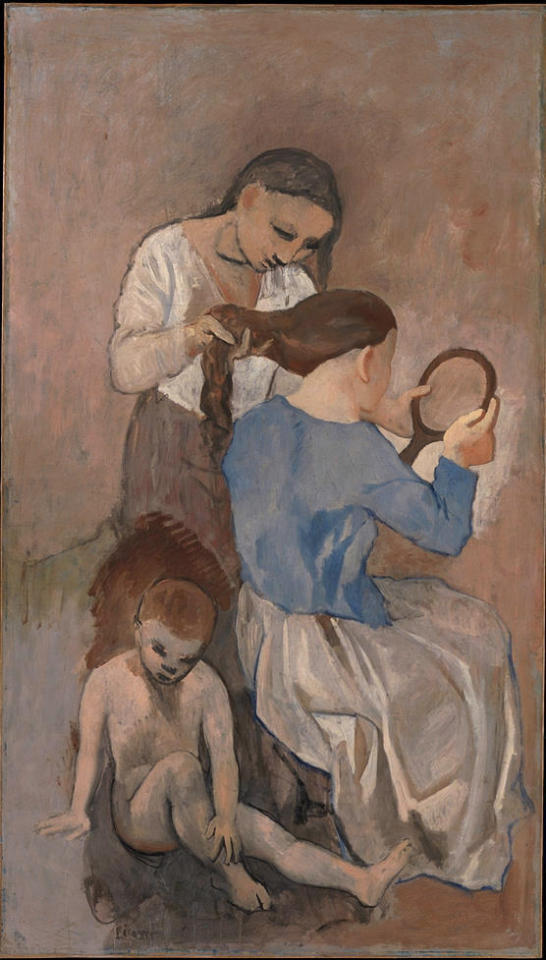
MWW Artwork of the Day (4/26/24) Pablo Picasso (Spanish, 1881-1973) La coiffure (1906) Oil on canvas, 174.9 x 99.7 cm. The Metropolitan Museum of Art, New York (Wolfe Fund)
Although today art historians associate a woman at her toilette with Edgar Degas's famous series of nude bathers, shown in Paris at the 1886 Impressionist exhibition and repeated in his oeuvre until about 1910, it is unlikely that Picasso could have seen many examples. Degas had drawn inspiration from the Neoclassical painter Jean-Auguste-Dominique Ingres, and that same source was used by Pierre Puvis de Chavannes and Auguste Renoir in their development of the theme at the end of the nineteenth century. In an odd twist, however, Picasso chose to suppress in this picture all the eroticism that normally attends the subject. Instead, he turns the picture into a contrapuntal variation on the Holy Family, with echoes of Leonardo's "Virgin and Saint Anne" at the Musée du Louvre.
4 notes
·
View notes
Text

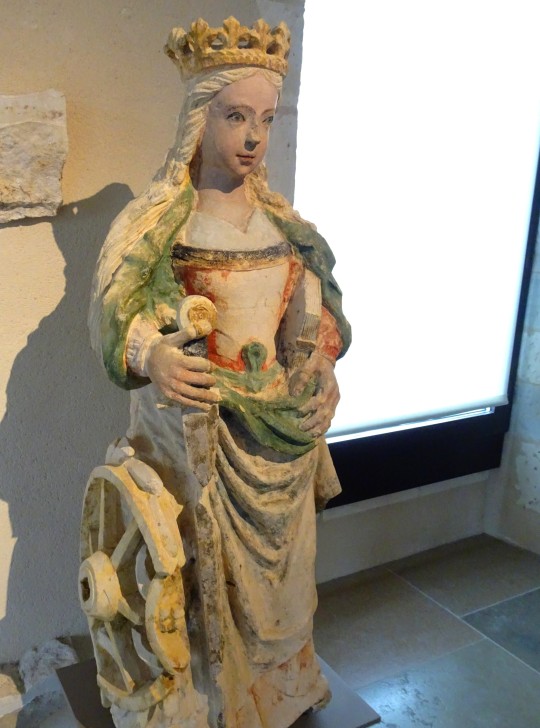
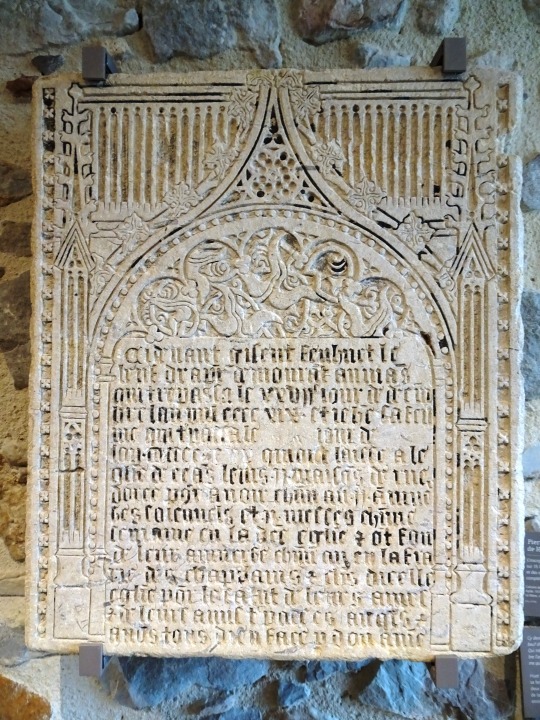


Quatrième et ultime étape de mon périple dans l'Ouest pour retrouver des ami(e)s lointain(e)s il y a un bon mois déjà : ma sœur Dominique et son mari, à Alençon, aux confins de la Normandie et des Pays de Loire.
On passe une journée au Mans. Visite du Carré Plantagenêt, musée d'histoire de la ville.
tête d'évêque - Le Mans, XIVème s.
Sainte Catherine d'Alexandrie et sa roue de supplice - Sarthe, XVème s.
pierre tombale de Huët le Bœuf - Le Mans, 1420
Christ - Sarthe, 1200
sarcophage mérovingien réutilisé pour Ermecin, recluse, XIe s. ...puis par Mathieu Leperier, tailleur de pierre (d'où le marteau gravé), XVe s. !
#le mans#archéologie#carré pantagenêt#médiéval#mérovingien#moyen-âge#évêque#gothique#sainte#sainte catherine#sainte catherine d'alexandrie#roue#supplice#pierre tombale#huët le boeuf#christ#sarcophage#ermecin#recluse#mathieu leperier#tailleur de pierre
3 notes
·
View notes
Text

Ophelia.
#legend of the galactic heroes#ginga eiyuu densetsu#logh#elfriede von kohlrausch#dominique saint pierre
52 notes
·
View notes
Text

Jean Auguste Dominique Ingres - Sketch Of Head Of St… And Hands Of St. John For Jesus Remet A Saint Pierre Les Clefs Du Paradis
5 notes
·
View notes
Text
INDEX
CLASSICO E ROMANTICO
William Blake, Newton
Jöhan Heinrich Füssli, L'incubo
Étienne-Luoise Boullée, Progetto per il cenotafio di Newton
Claude-Nicolas Ledoux, Casa delle Guardie campestri
John Constable, La chiusa
e il mulino di Flatford
William Turner, Mare in tempesta
Francisco Goya, Fucilazione
Jacques-Louis David, La morte di Marat
Antonio Canova, Monumento di Maria Cristina d’Austria
Jean-August-Dominique Ingres, La bagnante di Valpingon
Théodore Géricault, La zattera della Medusa
Eugène Delacroix, La Libertà guida il popolo
Lorenzo Bartolini, Monumento funebre della contessa Zamoyska
François Rude, Rilievo dell'Arco di trionfo di Parigi Camille Corot, La cattedrale di Chartres
Théodore Rousseau, Temporale; veduta della piana di Montmartre
Honoré Daumier, Vogliamo Barabba
Constantin Guys, Per la strada
Honoré Daumier, Il vagone di terza classe
François Millet, L’Angelus
Camille Pissarro, Sentiero nel bosco in estate
LA REALTA' E LA COSCIENZA (l’Impressionismo; La fotografia; Il Neo-impressionismo; Il Simbolismo; L’architettura degli ingegneri)
Gustave Courbet, Ragazze in riva alla Senna (Estate)
Edouard Manet, Le déjeuner sur l'herbe
Alfred Sisley, Isola della Grande Jatte
Claude Monet, Regate ad Argenteuil;
Claude Monet, La Cattedrale di Rouen
Auguste Renoir, Le Moulin de la Galette
Edgar Degas, L'absinthe
Paul Cézanne, L'asino e i ladri
Paul Cézanne, La casa dell'impiccato ad Auvers (Non Aversa)
Paul Cézanne, I giocatori di carte
Paul Cézanne, La montagna Sainte-Victoire
Georges Seurat, Una domenica pomeriggio all’isola della Grande-Jatte
Paul Signac, Ingresso del porto a Marsiglia
Paul Gauguin, Te Tamari No Atua
Vincent van Gogh, Ritratto del postino Roulin
Henri de Toulouse-Lautrec, La toilette
Henri Rousseau detto il Doganiere, La Guerra
Odilon Redon, Nascita di Venere
Gustave Moreau, L'apparizione
Pierre Bonnard, La toilette del mattino
Auguste Rodin, Monumento a Balzac
Medardo Rosso, Impressione di bambino davanti alle cucine economiche
I pittori della cerchia di Mallarmé
Edouard Vuillard, La pappa di Annette.
James MeNeill Whistler, Notturno in blu e oro: il vecchio ponte di Battersea
L' OTTOCENTO IN ITALIA, IN GERMANIA, IN INGHILTERRA
1. Giovanni Fattori, In vedetta
IL MODERNISMO (Urbanistica e architettura moderniste; Art Nouveau; La pittura del Modernismo; Pont-Aven e Nabis)
1. Antoni Gaudí, Casa Milá a Barcellona
2. Adolf Loos, Casa Steiner a Vienna
3. Antoni Gaudi, Il Parco Güell a Barcellona
L’ARTE COME ESPRESSIONE (Espressionismo; La grafica dell’Espressionismo)
1. Edvard Munch, Pubertà
André Derain, Donna in camicia
Ernst Ludwig Kirchner, Marcella
Henri Matisse, La danza
Emil Nolde, Rose rosse e gialle
Oskar Kokoschka, Chamonix, Monte Bianco
L’EPOCA DEL FUNZIONALISMO (Urbanistica, architettura, disegno industriale; Pittura e scultura; Der blaue Reiter; L’avanguardia russa; La situazione italiana; École de Paris; Dada; Il Surrealismo; La situazione in Inghilterra; La situazione italiana: Metafisica, Novecento, anti-Novecento)
Le Corbusier, Villa Savoye a Poissy
Le Corbusier, Cappella di Nötre-Dame-du-Haute a Ronchamp
Walter Gropius, La Bauhaus a Dessau
Ludwig Mies van der Rohe, Plastico di un grattacielo in verro per Chicago
Ludwig Mies van der Rohe, Seagram Buildings a New York
Tre progetti per il Palazzo dei Soviet. Le Corbusier e Pierre Jeanneret,
Walter Gropius, Bertold Luberkin,
Teo van Docsburg e Hans Arp, Cinema-ristorante L'Aubette a Strasburgo.
Thomas Gerrit Rietveld, Poltrona con elementi in nero, rosso, blu
Pier Mondrian, Composizione in rosso, giallo, blu
Aivar Aalto, Sanatorio a Paimio - Poltrona
Frank Lloyd Wright, Casa Kaufmann a Bear Run
Pablo Picasso, I saltimbanchi; Les demoiselles d’Avignon; Natura morta spagnola
Georges Braque, Narura morta con l’asso di fiori
Robert Delaunay, Tour Eiffel
Juan Gris, Natura morta con fruttiera e bottiglia d’acqua
Georges Braque, Natura morta con credenza: Café-bar
Marcel Duchamp, Nu descendant un escalier n. 2
Umberto Boccioni, Forme uniche nella continuità dello spazio
Giacomo Balla, Automobile in corsa
Vasili; Kandinsky, Primo acquerello astratto; Punte nell'arco
Paul Klee, Strada principale e strade laterali
Anton Pevsner, Costruzione dinamica
Naum Gabo, Costruzione nello spazio; Il cristallo
Fernand Léger, Composizione con tre figure
Joan Miró, La lezione di sci; Donne e uccello al chiaro di luna
Giuseppe Terragni, Progetto dell'Asilo Sant'Elia a Como
Atanasio Soldati, Composizione
Constantin Brancusi, La Maiastra
Amedeo Modigliani, Ritratto di Léopold Zborowski
Georges Rouault, Cristo Deriso
Marc Chagall, A la Russie, aux anes et aux autres
Pablo Picasso, Guernica
René Magritte, La condizione umana Il
Man Ray, Motivo perpetuo
Henry Moore, Figura sdraiata
Alexander Calder, Mobile
Ben Nicholson, Feb. 28-53 (Vertical Seconds)
Francis Bacon, Studio dal ritratto di Innocenzo X di Velázquez
Diego Rivera, L'esecuzione dell'imperatore Massimiliano
David Alfaro Sigueiros, Morte all'invasore
Giorgio De Chirico, Le Muse inquietanti
Carlo Carrà, L'amante dell'ingegnere
Alberto Savinio, Nella foresta
Osvaldo Licini, Amalasunta su fondo blu
Giorgio Morandi, Natura morta con fruttiera
7. LA CRISI DELL'ARTE COME "SCIENZA EUROPEA" (Urbanistica e architettura; La ricerca visiva; La pittura negli Stati Uniti)
Ellsworth Kelly, Verde, blu, rosso
Morris Louis, Gamma Delta
László Moholy-Nagy, Composizione Q XX
Julius Bissier, 25 settembre 1963?
Josef Albers, Omaggio al quadrato
Arshile Gorky, Giardino a Sochi
Jean Fautrier, Nudo
Jean Dubuffet, Orateur
André Masson, Les Chevaliers
Hans Hartung, Composizione
Jackson Pollock, Sentieri ondulati
Mark Rothko, Rosso e blu su rosso
Albero Burri, Sacco B.
Antoni Tápies, Bianco e arancione
Giuseppe Capogrossi, Superficie 114
Lucio Fontana, Concetto spaziale: attesa
Alberto Giacometti, Figura
Ettore Colla, Officina solare
Mark Tobey, Circus transfigured
Georges Mathieu, Cast
Victor Vasarély, Composizione.
Kenneth Noland, Empireo
Clyfford Still, 1962-D
Emilio Vedova, Plurimo n. 1; Le mani addosso
Robert Rauschenberg, Letto
Mimmo Rotella, Marilyn
Roy Lichtenstein, Il tempio di Apollo
Andy Warhol, Marilyn Monroe
4 notes
·
View notes